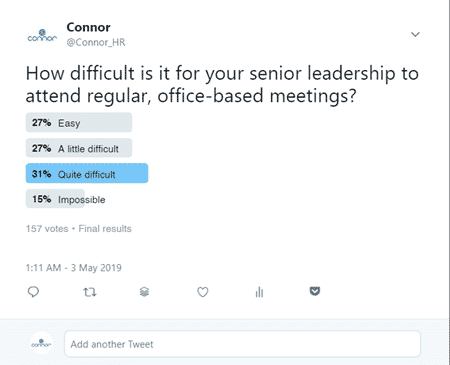Your organisation, no doubt, thinks constantly about how best to communicate with its customers. And about how to get the best out of its employees. But has the way it uses coaching evolved fast enough to keep pace with change?
Many of the organisations we speak with tell us that they feel their coaching programmes look and feel much the same as they did a decade ago. As a result, they just aren’t meshing as well as they should with the changing demands of their workplaces and their people.
In fact, when we ran a recent twitter poll asking, ”Of the coaching you buy for your business what percentage of time, is lost, wasted or under utilised?”, almost half of respondents (46%) thought that more than 20% is wasted.

Doesn’t this suggest a missed opportunity? Because when done right, coaching is of huge benefit in helping individuals realise their potential and to help organisations to deliver on their goals.
So what’s gone wrong with the traditional model of coaching? How can it be fixed so that coaching delivers better value for money for your organisation?
1. One-size-fits-all programmes deliver less impact
Consider your traditional coaching programme: a fixed package of sessions that’s essentially the same offer irrespective of the needs of individuals.
- But don’t the needs and learning style of individuals vary? Yes, they do.
- Some need more support. Others less.
- Some benefit most from personality assessments. Others from tools like Voiceprint.
- Some learn best in the morning. Others later in the day.
Is there any reason not to tailor coaching programmes to the specific needs and learning styles of individuals? Because that’s the way to maximise coaching effectiveness and the sustainability of what is learnt.
The more off-the-shelf coaching programmes are, the greater the risk that individuals find aspects of the coaching irrelevant to their needs. The result? Engagement levels drop. And those receiving coaching slip from being active learners to being passive participants.
In other words, traditional coaching programmes – those that can’t be easily adapted to individual needs and learning styles – end up being less effective. They end up delivering less value for money.
2. Inflexible coaching programmes fail to support the modern working world
Traditional coaching programmes, too, often lack flexibility. Say you buy a package of two-hour sessions to be delivered face-to-face in the office. Is there a problem here? Well, it depends on how flexible that package is. For example, can delivery of the sessions easily be adjusted when circumstances change?
Imagine a business trip abroad that gets arranged at short notice, clashing with a scheduled coaching session. Can the coaching session still be accommodated alongside the trip – through being delivered by phone or webcam? If not, then progress with coaching will be interrupted, unnecessarily. Or think about employees who are not permanently based in the office and have a flexible working pattern. How is this coaching delivered to them? Do they have to take time out of their small number of hours when they are in the office to receive the coaching? Or can they access coaching remotely?
Another poll we conducted recently concluded that only 27% of senior leaders find it easy to attend regular, office-based meetings. It’s plain that traditional coaching programmes lack the flexibility to easily accommodate these common situations. They don’t support the flexible working that’s at the heart of the modern workplace—and so are less effective.

3. Traditional coaching programmes can be ‘too expensive’ to offer widely
There’s another problem with the inflexibility of traditional coaching programmes: typically they come as a single block of sessions taken by one individual, which can’t be broken up into coaching ‘capacity’ to be taken by different individuals who would benefit from it. This means the cost of the coaching per individual is that of the entire per-person package. As a result, the relatively high cost of an entire coaching programmes limits availability to the ‘lucky few’ – usually senior executives.
Why does this matter? It matters because more junior, but high-potential employees – those who might strongly benefit from elements within that coaching programme – miss out on coaching entirely. Risking a hit to employee satisfaction and retention.
What’s the solution to this problem?
Imagine if coaching programmes could be seen more as ‘coaching capacity’ and spread where they were most needed. Different individuals could then cherry-pick the elements they most needed while ignoring those they didn’t. The overall cost would be broadly the same. But the return on investment would be higher as the relevant coaching elements would be delivered where they were most needed. And most effective. How would that increase the value of coaching to your organisation?
It’s time for coaching to change
Traditional coaching is no longer an efficient model for many organisations, but it’s not the only way that coaching can be delivered. In our next post in this series, we’ll look at how traditional coaching can evolve to become more adaptive to the needs of the modern workplace. And so to better support a modern learning and development programme.



